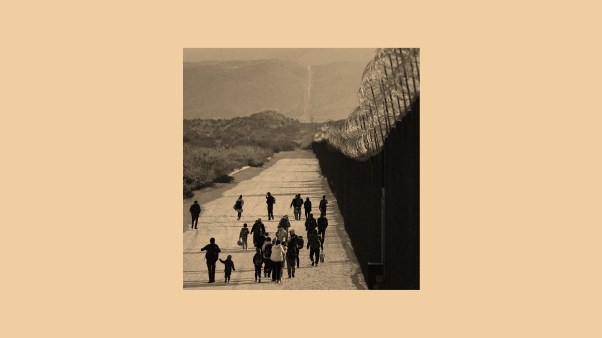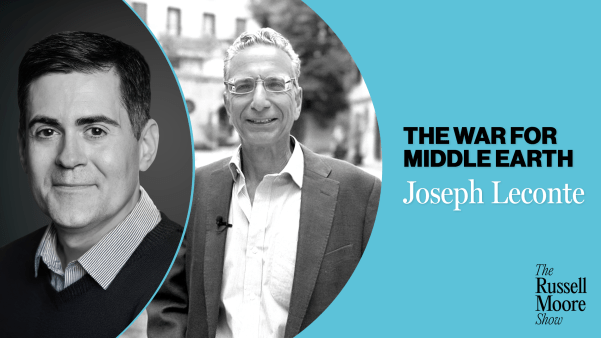My close friend, Nathan, is one of my favorite people on earth. He and I have intractable and substantial theological disagreements, but we love and enjoy each other. We discuss ideas and occasionally collaborate on projects. We both wonder, though: If we had met now, as opposed to as college students in the late ’90s, would we even have become friends? The cultural pressure to sort ourselves into ideologically pure and homogenous cliques is strong—much stronger now than it was 20 years ago when we met—and it’s eroding our ability as a society to seek common ground and common friendship.
There is a growing cultural assumption that the world is neatly divided between good guys and bad guys, white hats and black hats. This unimaginative calcification forces many of our cultural and theological conversations into a stalemate—every event produces thousands of takes that are boringly predictable. The lines are drawn clearly and brightly and there’s nothing left to do but shout at each other.
As we see this intense polarization in politics and theology—and in the heightened and heated rhetoric that social media inspires—some public figures sound renewed public calls for moderation. Others denounce “moderation” as a strategy of the privileged that ultimately protects the status quo. In her Washington Post piece earlier this year pointedly titled “Centrism and Moderation? No Thanks,” historian April Holm rejects the idea that attempts at moderation are virtuous. “The logic of calls to prioritize civility in public exchanges and of the insistence on seeing moral equivalence on both sides of every debate . . . are available only to those who are not, themselves, marginalized,” she writes.
She roots her argument in a historical survey of the ways that calls for moderation have been misused in times of political turmoil, in particular during the Civil War. One 19th-century Kentucky clergyman, who refused to come out for or against slavery, said, “By our superior moderation [we] put ourselves clearly in the right.” Of course, this now rings hollow. Taking a neutral stance on abolition is not righteous simply because it was, at the time, seemingly moderate.
So how do we find common ground? How do we seek truth and charity together? Is there a way to maintain our common humanity in the midst of cultural, theological, and political turmoil while still holding deep and passionate convictions?
We are to pursue chastity, honesty, and justice in ways that are radical, countercultural, and self-sacrificing. Yet as we do so, we actively seek to avoid the pitfalls of vice that result from extremism.
Throughout church history, the pursuit of theological truth and virtue was consistently understood as a pursuit of the via media, or “middle way.” At its worst, the via media can be easily misconstrued (or used) as a call to cowardly fence-sitting or half-heartedness when the moment calls for decisive action. It degenerates into a Goldilocks approach to theology and ethics—looking for a comfortable niche that is not too hot or too cold but “just right.” Goldilocks, for all her charms, would not have made a great church leader, and this view of doctrine and practice tends toward a bland commitment to a squishy mean, an imagined moderation that affirms nothing more than the cultural zeitgeist.
But if we understand it historically, the via media can help the church, as a community, hold our convictions passionately yet humbly. It might also help us reweave the fabric of our civic discourse.
An Ancient Way
Claims of following the “middle path” run the length of church history. A via media view of virtue echoes throughout the writings of early church fathers, medieval history, and the Reformation. Unsurprisingly, leaders in different traditions have long debated who, precisely, embodies the middle way. Anglicans claimed (and still claim) to inhabit the middle way between Roman Catholics and the Reformers, even while Luther claimed that his theology was the via media between Roman Catholics and the Anabaptists. (They, of course, could both be right).
The medieval scholar Thomas Aquinas wrote extensively on the via media. He viewed Christian virtue as a mean or a middle way between extremes. “The nature of a mean is incompatible with that which is extreme,” he wrote. Yet, paradoxically, he said, “The nature of a virtue is to be something extreme.”
In other words, virtue is incompatible with mediocrity and tepidity, yet virtue seeks a middle way. So how do we reconcile these seemingly opposed concepts? The “mean,” for Aquinas, is not a calling to a perfect average of two extremes, nor is it marked by neutrality or a lack of conviction. Instead, we are called to wisdom—a profound commitment to do the right thing in the right way toward the right end. Aquinas goes on to say that Christian virtue doesn’t involve being moderately chaste or moderately honest or moderately just. We are to pursue chastity, honesty, and justice in ways that are radical, countercultural, and self-sacrificing. Yet as we do so, we actively seek to avoid the pitfalls of vice that result from extremism.
Christian chastity, for instance, has two opposites: both licentiousness—sex addiction, promiscuity, adultery, pornography, and the like—and also hatred of the body—denigration of the goodness of the body, self-harm, and shame about sexuality. In fleeing from the former, we don’t want to inadvertently fall into the latter (or vice versa). Similarly, we seek justice to battle the vices of apathy, callousness, and greed, but in our zeal, we don’t want to inadvertently create more injustice through recklessness, arrogance, or hatred of the powerful.
When we embrace a via media approach to doctrine and ethics, we recognize that truth is preserved in extreme positions but reject falsehoods that arise out of those extreme positions. The pursuit of Christian virtue, then, often feels like balancing on a tightrope. There’s always more than one way to fall.
So, to get to brass tacks, what does this tight-rope act actually look like in practice?
In relationships where people hold ideological differences—like my friendship with Nathan—none of us should assume a theological posture of “neutrality” or passionless vagueness. Our differences mean something significant. They matter deeply. Instead, embracing the via media means developing the practice of looking at what’s right and good in the ideological or theological “other side,” and then striving to incorporate this insight into one’s own position. This act, in itself, is radically countercultural.
The “middle way” allows us to approach divisive, hot-button issues in ways that are surprising and unpredictable.
Second, the via media calls us not to hold our convictions with timorousness or indecision, but with humility. It asks that we initiate and assume a hermeneutic of charity with every person with whom we engage, and it invites us to enter into seemingly recalcitrant conflict with wonder and humanity. Certainly, we need critique and condemnation of untruth, injustice, and wrong-headed thinking. Nonetheless, the “middle way” encourages us to also slow down and listen to the good in our opponents’ positions, and it forces us to resist the narrative that listening well is evidence of weakness or insufficient passion.
Our era is marked by a renewed commitment to fundamentalism—both on the left and the right. As a result, many of us harbor a deep fear of “slippery slopes.” But as my very wise former InterVarsity supervisor often quipped, “What if truth is found on the slope?” The via media is not only an approach to virtue ethics or theology; it is primarily a posture and a set of embodied practices that condition us to work diligently and rigorously to find truth, even when it’s “on the slope.”
Finally, the posture and practice of the via media engenders in us a “chronological humility.” There is a tendency in all of us to think that our moment in history is the most pressing and important one, and that we alone have adequate historical standing to judge all those who’ve come before us. In reality, what future generations will find most troubling about our contemporary moment are likely things that we don’t even notice now—things so common to all of us, right and left, that we’re blind to them.
As C. S. Lewis wrote, “We may be sure that the characteristic blindness of the twentieth century—the blindness about which posterity will ask, ‘But how could they have thought that?’—lies where we have never suspected it, and concerns something about which there is untroubled agreement.”
One of the most powerful practices of the via media, then, is to identify and understand the often hidden, root assumptions and presuppositions of both sides of an argument and to examine those in light of the truth of Scripture as well as the wide and long history of the global church.
Seeking a Radical Alternative
For all it has to offer, there are limits to a via media approach to theology, ethics, and spirituality. In historical Anglicanism, for example, which explicitly sought a via media, some things were left to mystery—like in what way, precisely, Christ is present in the sacraments. Yet Anglicans took strong theological positions when necessary. They specified two “sacraments of the gospel,” baptism and communion (while naming five other “sacraments of the church” that do not have the same standing), and they rejected both a purely memorialist and a transubstantiationist view of the Eucharist. They did not leave everything to the unknowable, much less to personal, subjective preference. In other words, the via media often seeks a synthesis at the far side of antithesis, but it does not allow theological or ethical questions to be simply shrugged off, dismissed, or answered too easily.
In order to seek and embrace truth, we as a church inevitably need lines in the sand. And yet these lines are not always located where our broader culture expects—or demands—them to be. Tim Keller wrote in his New York Times op-ed about the unhelpful practice of “package deal” ethics. “This emphasis on package deals puts pressure on Christians in politics,” he writes. “For example, following both the Bible and the early church, Christians should be committed to racial justice and the poor, but also to the understanding that sex is only for marriage and for nurturing family. One of those views seems liberal and the other looks oppressively conservative. The historical Christian positions on social issues do not fit into contemporary political alignments.”
Embracing the via media allows those on both the left and right to reject this “false bundling.” The global church has always been—and by God’s grace always will be—an ethically alternative community. Radically so.
The “middle way” allows us to approach divisive, hot-button issues in ways that are surprising and unpredictable. Christian history constantly witnesses to the arbitrariness of our culture’s current fundamentalism. For example, the early church father John Chrysostom held a robust Christian view of sexual chastity and the beauty of celibacy that would now seem radical—anything but moderate—even to those who would be considered religiously conservative today. Yet Chrysostom’s constant call to economic justice, extreme simplicity and generosity, uncompromising care for the poor, and bold denunciation of the greed of those in power is more radical than any leftist in America today. And, perhaps more importantly, a deep understanding of both Scripture and the via media would affirm that he held these (now seemingly opposed) radical views, not in spite of each other or as unrelated ethical convictions, but because they holistically cohere. They are part of the same seamless ethical cloth.
The early church in general reflects extremes of biblical conviction. They were a shockingly alternative sexual community, defying the destructively promiscuous and licentious culture around them; they practiced a radical commitment to unborn, abandoned, and orphaned children; and they committed themselves to nonviolence and care for the vulnerable in ways that confounded the ethical categories of their own culture and would confound ours, as well. The via media did not make them simply “moderate.” They were radicals in so far as their profound and rigorous theological commitments allowed them to hold to and suffer for convictions that didn’t fit any easily constructed paradigm.
In the end, the idea of seeking a via media is a useful tutor in our moment of history and its particular call to extremism. Yet to be faithful to its ancient use, we must not interpret it simply as a call to moderation for moderation’s sake, because the positions arrived at by the via media will inevitably disturb the political status quo. We are called to radically seek virtue—an extreme endeavor—yet resist being co-opted by any extreme other than Jesus’s self-emptying, life-giving, always-and-everywhere surprising way.
Tish Harrison Warren is an Anglican priest, writer-in-residence at Church of the Ascension (Pittsburgh), a member of The Pelican Project, and the author of Liturgy of the Ordinary: Sacred Practices in Everyday Life.










